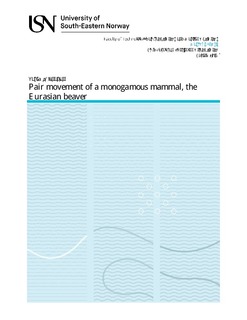Pair movement of a monogamous mammal, the Eurasian beaver
Master thesis
Published version
Permanent lenke
http://hdl.handle.net/11250/2611013Utgivelsesdato
2019Metadata
Vis full innførselSamlinger
Sammendrag
Studying the cohesion of monogamous pairs is an important component in understanding their social relationships. I used the Eurasian beaver (Castor fiber) to investigate how movement patterns and space use relate to their partners in an obligate monogamous and territorial mammal. I analyzed 1984 paired GPS positions from 14 pairs tagged between 2010 to 2018 and calculated the territory overlap of pairs, their distance to each other, and the time spent near territory borders, the main lodge, and in other frequently used clusters. Territory length was of similar size between partners with a high degree of overlap. In addition, more than half of their clusters overlapped although they were rarely located in the same cluster at the same time. Beavers appeared to move independently from each other with relatively large distances between partners (mean ± SD: 480 ± 427 m) that did not differ from their distance to random positions. Beavers in larger territories were overall farther apart, and beavers were the closest at the beginning and end of their nightly active periods when they were also closest to their lodge. They were also closer during the autumn compared to the spring. One partner being in a territory border zone did not influence whether the other one was, although when they were both in the borders concurrently they were more likely to be on the same side. They were also more likely to be on the same side of the territory when not in border zones. Overall, beavers demonstrate low cohesion with their partners which may be a way to avoid predation on multiple family members or to reduce direct competition for resources.
